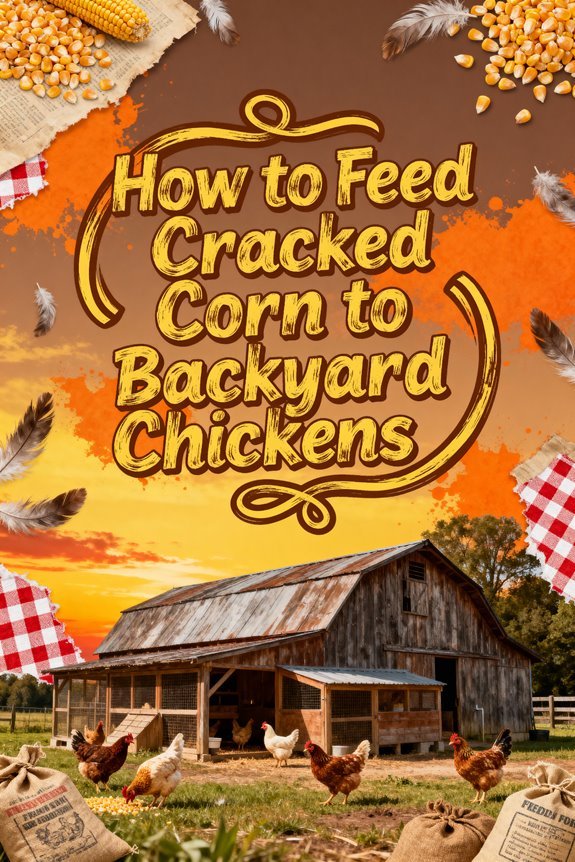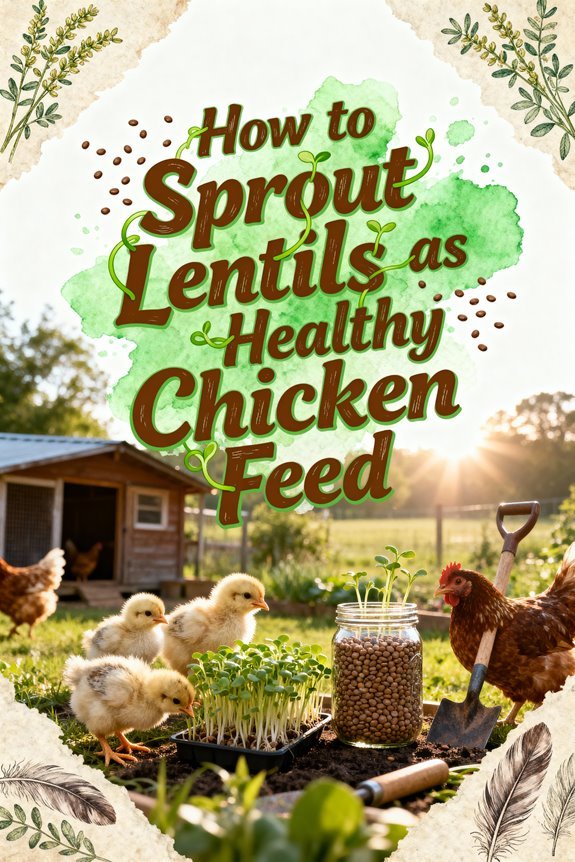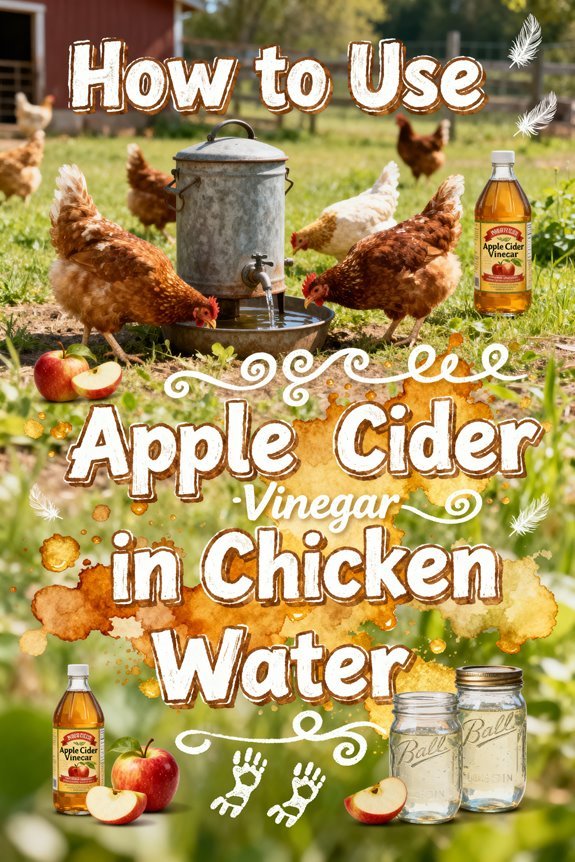How to Feed Cracked Corn to Backyard Chickens
You’ll want to feed cracked corn to your backyard chickens as a treat following the 90/10 rule, where treats make up no more than 10% of their daily diet. Offer it once daily before roosting, limiting portions to 1-2% of their feed weight. Store it in dry, sealed containers and adjust amounts seasonally – more in winter for energy, less in summer. Understanding proper portion control and monitoring helps prevent nutritional imbalances that can impact your flock’s health.
The Role of Cracked Corn in Chicken Nutrition
Three key nutritional aspects define cracked corn’s role in chicken diets: its high energy content, limited protein profile, and minimal micronutrient density. You’ll find cracked corn benefits primarily stem from its readily digestible carbohydrates, which provide quick energy for maintaining body temperature and supporting daily activities. Its high caloric content makes it especially valuable during winter months. Popular commercial feeds like Purina layer feeds often incorporate cracked corn alongside protein-rich ingredients for balanced nutrition.
While it’s an excellent energy source, you must address its nutritional gaps by incorporating it as part of a balanced feeding program. The 7.5-9.5% protein content won’t sustain ideal egg production or growth, and its modest fat levels don’t meet poultry requirements. Additionally, cracked corn lacks sufficient vitamins and minerals, particularly calcium and vitamin A, which are vital for eggshell formation and overall health. You’ll need to supplement with complete layer feeds to guarantee your flock receives adequate nutrition. Layer feeds containing essential amino acids are crucial for maintaining optimal egg production and feather development.
Essential Guidelines for Portion Control
Proper portion control forms the cornerstone of effectively incorporating cracked corn into your chickens’ diet. You’ll need to follow the 90/10 feeding rule, ensuring that cracked corn and other treats don’t exceed 10% of their total daily intake. For laying hens, limit cracked corn to 1-2% of daily feed weight, typically 0.04 to 0.08 ounces per bird if daily feed is 4 ounces.
Remember that cracked corn is low in protein and cannot support optimal egg production on its own. Monitor feeding frequency by offering cracked corn just before roosting time, and don’t exceed once-daily servings. You’ll want to adjust portion sizes seasonally, allowing slightly more during cold weather for extra energy. Watch your birds closely for signs of overfeeding, such as weight gain or reduced egg production, and reduce portion sizes accordingly. Use measured amounts rather than free-feeding to maintain ideal nutritional balance.
Best Practices for Seasonal Feeding
While seasonal changes greatly impact your chickens’ nutritional needs, adapting your cracked corn feeding strategy throughout the year guarantees ideal flock health. You’ll need to make seasonal adjustments based on temperature considerations, reducing portions during summer’s heat and increasing them moderately in winter’s cold. High energy corn can enhance the color of egg yolks when fed regularly. Similar to balanced protein levels found in quinoa, maintaining proper nutritional ratios is essential for flock health.
In summer, offer cracked corn during cooler hours to prevent heat stress, and keep portions minimal. During winter, you can increase amounts slightly to help generate body warmth, especially when fed before roosting. However, never exceed 10% of their total daily diet. Feed cracked corn just before bedtime for the best digestive benefits. As seasons evolve, gradually modify portions to prevent digestive issues, and maintain constant access to fresh water year-round. In spring and fall, maintain minimal portions as supplemental treats, focusing on balanced nutrition through complete feed.
Recognizing Signs of Overfeeding
Successful cracked corn feeding requires vigilant monitoring for signs of overfeeding, which can lead to serious health complications in your flock. You’ll need to watch for key physical indicators, including excessive body weight and difficulty feeling the keel bone through fat deposits. Lethargy and reduced foraging activity are also telltale signs. A concerning sign is when chickens exhibit labored breathing, particularly during warm weather.
Among the most serious overfeeding consequences is fatty liver hemorrhagic syndrome, which can be fatal. Poor bedding choices like using pine shavings bedding can compound respiratory issues from overfeeding. Consider offering a natural flock block to encourage healthy foraging behaviors and reduce boredom-related overeating. Behavioral changes often manifest as aggressive competition for feed, increased water consumption, and stress-induced feather pecking. You’ll notice deteriorating coop conditions, with more frequent cleaning needed due to excessive droppings. Watch for nutritional imbalance symptoms like poor feather quality, coordination issues, and irregular egg production, even when birds appear well-fed.
Safe Storage and Preparation Methods
Safe storage practices form the foundation of maintaining cracked corn’s nutritional integrity and preventing harmful contamination. You’ll need to maintain proper storage conditions by keeping the corn in a dry environment with approximately 13% moisture levels and storing it in food-safe plastic containers away from direct sunlight.
When implementing feeding techniques, make sure you’re mixing cracked corn with other grains for balanced nutrition. Monitor your storage areas regularly for signs of mold or moisture, as these conditions can lead to dangerous mycotoxin development. Humidity levels above 65% promote fungal growth and can quickly compromise feed quality. You’ll want to use containers with secure lids to prevent pest infiltration and maintain freshness. During winter months, you can increase portions slightly to help chickens maintain body warmth, but always practice moderation to prevent obesity-related health issues.
Balancing Cracked Corn With Other Treats
Beyond proper storage practices, balancing cracked corn with complementary treats forms a cornerstone of effective backyard chicken nutrition. You’ll need to limit cracked corn to 10% of your chickens’ diet while incorporating cracked corn alternatives such as dried mealworms, fresh fruits, and vegetables to guarantee proper nutrition. The 90/10 rule ensures your chickens maintain optimal egg production and shell strength.
For optimal yolk quality, offer your chickens dark leafy greens daily alongside their regular feed. Treat variety isn’t just about nutrition—it’s essential for reducing boredom and preventing pecking behaviors. You can maximize your flock’s health by offering high-protein treats alongside their complete feed. A layer feed transition should occur when pullets reach egg-laying age around 16-20 weeks. Consider mixing different grains to encourage natural foraging behavior, but don’t let treats replace their primary layer feed. During winter months, you can slightly increase cracked corn portions to help with heat production, but always maintain moderation to prevent nutritional imbalances and potential health complications.




